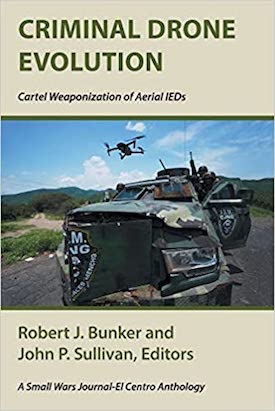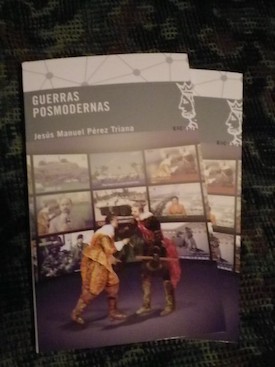El Centro
Commentary – A designation constraining peace: why the US’ delisting of FARC as a foreign terrorist organisation is critical
- Read more about Commentary – A designation constraining peace: why the US’ delisting of FARC as a foreign terrorist organisation is critical
- 1 comment
About the Author(s)
The Triple Border, a criminal haven
About the Author(s)
La Triple Frontera, refugio criminal
About the Author(s)
Commentary—Narcos: Mexico Season 3: A View From El Paso and Ciudad Juárez
About the Author(s)
SWJ El Centro Book Review – Downtown Juárez: Underworlds of Violence & Abuse
- Read more about SWJ El Centro Book Review – Downtown Juárez: Underworlds of Violence & Abuse
- 2 comments
About the Author(s)
Corruption, Crime, and Gangs in Central America: Understanding the Root Causes
- Read more about Corruption, Crime, and Gangs in Central America: Understanding the Root Causes
- 1 comment
About the Author(s)
Criminal Drone Evolution: Cartel Weaponization of Aerial IEDs
Criminal Drone Evolution: Cartel Weaponization of Aerial IEDs
Robert J. Bunker and John P. Sullivan, Editors
SWJ has released a new curated collection Criminal Drone Evolution: Cartel Weaponization of Aerial IEDs documenting the evolution of drone usage by criminal cartels, gangs, and criminal armed groups (CAGs) in Mexico and beyond. Cartel Drone Evolution demonstrates the development spread of drone technology and tactics, techniques, and procedures (TTPs) among criminal actors while also pointing toward future potentials.

This Small Wars Journal-El Centro Anthology contains a preface on criminal drone use by journalist David Hambling followed by a foreword describing drones within criminal orders-of battle (OOB) by Lisa J. Campbell. After and introduction by the editors , the text contains 22 chapters documenting the evolution of drone use in Mexico’s competitive narco-conflict ecology. It closes with a conclusion by the editors, an afterword by Conrad ‘Andy’ Dreby and Scott Crino on UAS potentials, a postscript by James T. Torrance on future unmanned systems threats, and five appendices.
Criminal Drone Evolution is the companion to the earlier curated collection Illicit Tactical Progress: Mexican Cartel Tactical Notes 2013-2020 , also edited by SWJ-El Centro Senior Fellows Robert J. Bunker and John P. Sullivan. Together these two works provide valuable insight into the development of criminal armed groups and the tactics, techniques, and procedures (TTPs) they employ.
Source: Robert J. Bunker and John P. Sullivan, Editors, Criminal Drone Evolution: Cartel Weaponization of Aerial IEDs. Bloomington: Xlibris, 2021.
Las olas del terrorismo y las insurgencias del futuro
Las olas del terrorismo y las insurgencias del futuro
"Las olas del terrorismo y las insurgencias del futuro (The waves of terrorism and the insurgencies of the future)" by Jesús M. Pérez Triana, the author of Guerras Posmodernas (Barcelona: Ediciones El Cobre, 2010). Pérez Triana, a Spanish sociologist, national security, and intelligence analyst explores future conflicts and post-modern wars in a three part series in Spanish at The Political Room.

The first essay, "Las olas del terrorismo y las insurgencias del futuro (I)," looks at the 'waves' of terrorism articulated by eminent terrorism scholar David C. Rapoport, Distinguished Professor Emeritus at the University of Southern California,[1] Los Angeles and founding editor of Terrorism and Political Violence.
The second, "Las olas del terrorismo y las insurgencias del futuro (II)," examines the evolution of insurgency, looking at Robert J. Bunker's works on Old and New Insurgency Forms,[2] including 'criminal insurgency' as articulated by John P. Sullivan,[3] and 'plutocratic insurgency.'[4]
The third and most recent, "Las olas del terrorismo y las insurgencias del futuro (III)," continues the exploration of post-modern wars by reviewing the rise of 'bloody sectarian' insurgency and terrorism:
"La primera forma emergente señalada por Robert J. Bunker es la 'sectaria sangrienta'. Se trata de grupos armados articulados en torno a una secta religiosa con 'prácticas sectarias, mundos utópicos, anhelos apocalípticos e incluso prácticas de sacrificios humanos (The first emerging form identified by Robert J. Bunker is the 'bloody sectarian.' These are armed groups articulated around a religious sect with 'sectarian practices, utopian worlds, apocalyptic yearnings and even human sacrifice practices'.)"[5]
The second form of new insurgency and terrorism identified by Bunker is 'neo-urban' with the rise of armed groups in 'feral cities.' The potential for 'virtual' insurgencies that operate solely and exclusively in the "ámbito de las redes de información (realm of information networks)" is also discussed.[6]
These three essays bring the work on emerging insurgency and terrorism to Spanish speaking reader. This blog note completes the circle and brings awareness of the discussion of criminal insurgencies in the Spanish literature to English-speaking readers. Pérez Triana tweets at @jpereztriana, he also blogs in Spanish at "Guerras Posmodernas."
Endnotes
[1] David C. Rappoprt, :"The Four Waves of Modern Terrorism" in John Horgan and Kurt Braddock, Eds. Terrorism Studies: A Reader. New York: Routledge. 2008, pp. 46-72.
[2] Robert J. Bunker, Old and New Insurgency Forms. Carlisle Barracks: Strategic Studies Institute, US Army War College, 2016.
[3] John P. Sullivan,"Transnational gangs: The impact of third generation gangs in Central America." Air & Space Power Journal−Español. Second Trimester (January) 2008.
[4] Robert J. Bunker and Pamela Liguri Bunker, Eds., Plutocratic Insurgency Reader. (A Small Wars Journal Book.) Bloomington: Xlibris. 2019.
[5] Here Pérez Triana cites Bunker, Old and New Insurgency Forms.
[6] Ibid.
